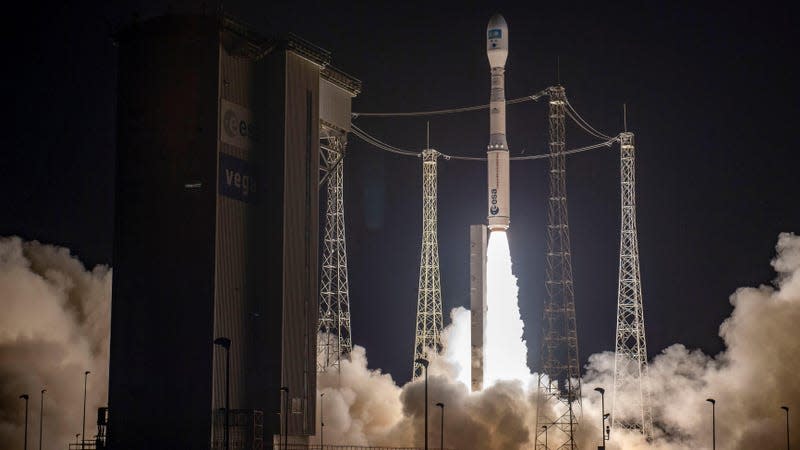Vega-C Rocket Forced to Self-Destruct With 2 Satellites On Board

The Vega-C rocket lifting off from its launch pad at the Kourou space base, French Guiana, December 21, 2022.
Arianespace’s medium-lift Vega-C rocket failed to reach orbit on its second mission, resulting in the destruction of the two satellites on board.
The rocket, developed by the European Space Agency (ESA), built by Italian company Avio, and operated by Arianespace, took off on Tuesday at 8:47 p.m. ET from the Kourou space base in French Guiana, carrying the Neo 5 and Neo 6 satellites for for Airbus’ Pléiades Neo Earth-imaging constellation.
Read more
The rocket’s first stage separated successfully from the second stage, but trouble ensued shortly thereafter. Around two minutes and 27 seconds after liftoff, the rocket’s second stage, called the Zefiro 40, experienced a catastrophic anomaly, Arianespace announced on Twitter.
Approximately 2 minutes and 27 seconds after liftoff an anomaly occurred on the Zefiro 40 thus ending the Vega C mission.
Data analyses are in progress to determine the reasons of this failure.#VV22— Arianespace (@Arianespace) December 21, 2022
“Following the nominal ignition of the second stage’s (Zefiro 40) engine around 144 seconds after lift-off, a decrease in the pressure was observed leading to the premature end of the mission,” Arianespace wrote in a statement.
“After this underpressure, we have observed the deviation of the trajectory and very strong anomalies, so unfortunately we can say that the mission is lost,” Stéphane Israël, chief executive of Arianespace, said on the launch webcast, as reported by SpaceNews. Per standard procedures, the rocket was ordered to self-destruct.
The satellites on board were meant to complete Airbus’ six-satellite constellation, providing high-resolution imagery of Earth.
Arianespace and ESA have appointed an independent inquiry commission to analyze the reason for the rocket’s failure and determine what needs to be done before Vega-C can resume flights, according to an Arianespace statement.
Vega-C was originally scheduled to launch on November 24, but the mission was delayed due to faulty equipment in the payload fairing separation system. The launch system hasn’t had the best track record, with the latest incident marking the third time a Vega rocket has suffered a mission failure in the last eight liftoffs, according to the BBC. In November 2020, a Vega rocket failed eight minutes into the mission, the result of human error.
It’s a disappointing follow-up to Vega-C’s debut this summer. On July 13, Vega-C successfully completed its inaugural flight, delivering the Italian Space Agency’s LARES-2 to orbit as its primary payload. Vega-C is a more powerful successor to the Vega launcher, which was in operation for 10 years. Vega-C is fitted with a more powerful first and second stage, along with an improved re-ignitable upper stage.
Tuesday’s mission marked the first time Vega-C carried a commercial payload, so it is unfortunate that the mission ended in failure. ESA is counting on Vega-C to deliver European payloads to orbit and maintain its presence in the growing space industry by virtue of possessing its own launch vehicle.
ESA is also getting ready to debut Ariane 6, the next-generation launcher to follow Ariane 5. Ariane 6 was originally slated for launch in 2020, but has suffered numerous delays, and is now scheduled to fly in 2023. “With Vega-C and Ariane 6, Europe will have a flexible, independent solution for a fast-changing launch market,” Daniel Neuenschwande, ESA’s director of Space Transportation, said in a statement in June.
Hopefully ESA can recover from the mission failure and get Vega-C back on track.
More: We Can’t Wait for These Futuristic Rockets to Finally Blast Off
More from Gizmodo
Sign up for Gizmodo's Newsletter. For the latest news, Facebook, Twitter and Instagram.

